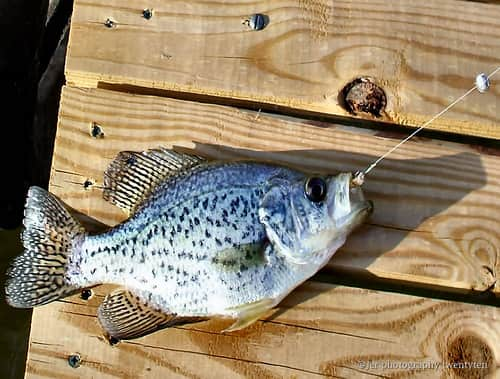Black Crappie Fishing Hot in Florida’s Cool Season
OutdoorHub 01.30.12

Many anglers target black crappie during the cooler months in Florida. Nonresident anglers avoiding the deeper chill up north congregate around these premier fisheries every winter to join Florida’s own fishers who enjoy pursuing and harvesting the succulent panfishes.
Crappies are high-profile fish with their own enthusiasts. CrappieUSA kicked off its 2012 season with an event at Flagler County’s Crescent Lake in January. Darrell Van Vactor, president of CrappieUSA, said, “The 2.63-pound crappie that won the big fish award on Crescent Lake was definitely a great crappie. In more than 25 years of crappie tournaments all over Florida, it is the best single fish weighed in, and the winning weight of 14.5 pounds for seven fish was also the best winning weight.”
He went on to say, “Crescent Lake is truly the best crappie water we have found in your state, and your agency is evidently doing a great management job there.”
Bass Pro Shops Crappie Master Tournament Trail will have its Florida State Championship in February on the Harris Chain of Lakes around Tavares. Anglers can find books, magazines, websites and television shows dedicated to great crappie fishing. The fast action, once you have located a school, makes crappie a great fish for families and youth.
Black crappies are also known as “speckled perch” or “specks” and are silver-white, speckled all over with black blotches. The fish are deep-bodied with two symmetrical fins along the top and bottom of the body. The Florida state record is 3.83 pounds, and the Big Catch Angler Recognition qualifying size is 14 inches or 2 pounds.
The Florida Fish and Wildlife Conservation Commission (FWC) annually issues a list of top crappie destinations, as well as lists for other sport fish. To see the list, go to MyFWC.com/Fishing and select “Freshwater” then “Sites and Forecasts”). This year, Cheree Steward, an FWC fisheries biologist in Eustis, helped compile the list.
The list includes:
- Rodman Reservoir (between Gainesville and Palatka);
- Lake Monroe (near Sanford; note that Crescent Lake is north of Lake Monroe on the St. Johns River);
- Lake Talquin (west of Tallahassee);
- Lake Weohyakapka /Walk-in-Water (east of Lake Wales);
- Lake Weir (southern Marion County);
- Lake Arbuckle (east of Frostproof);
- Lake Marian (southeast Osceola County, east of Lake Kissimmee);
- Lake Marion (east of Haines City);
- West Lake Tohopekaliga (south of the city of Kissimmee);
- Lake Kissimmee (east of Lake Wales);
- Mosaic Fish Management Area (southern Polk County);
- Lake Istokpoga (near Sebring);
- Lake Trafford (near Immokalee).
Steward points out that reports from local anglers, as well as data from trawling, electrofishing and creel surveys compiled by fisheries biologists, and knowledge of habitat trends all go into selecting these lakes. The list focuses on larger water bodies that have good access and can sustain more fishing effort, so even if your local lake isn’t on the list, don’t be afraid to try it. One of the best things about crappie fishing in Florida is that you can find them in almost all of our lakes.
Unlike many panfish, crappies spend much of their time offshore, feeding on small fish. Successful anglers drift through deeper water, fishing with small minnows or freshwater grass shrimp until they find a school. Try a light wire #4 hook and small split shot below a float. Speck anglers typically use several rods or poles, fishing at different depths until they pinpoint concentrations of fish. In the extreme, these are referred to as “spider rigs” for the way the rods look like spider legs sticking out from all sides of the boat. Specks move inshore to spawn during early spring, gathering in large numbers around heavy cover.
Crappie also strike artificial baits. Tipping a jig with a live minnow makes it especially effective. Night fishing for crappie with baits fished near a light can produce nice stringers, especially once it warms up.
After black bass, crappies are the second-most popular freshwater species in Florida, followed by bream, in terms of angler effort. Angler success rates over the past five years averaged approximately 1.2 crappie per hour statewide (compared with 1.9 for bream and 0.7 for bass).
Crappie provide a great fishing opportunity, especially this time of year, and can be an exciting way to introduce new anglers both young and old to the lifetime sport of fishing. Moreover, many anglers think they are one of the tastiest of freshwater fishes, so give them a try.

